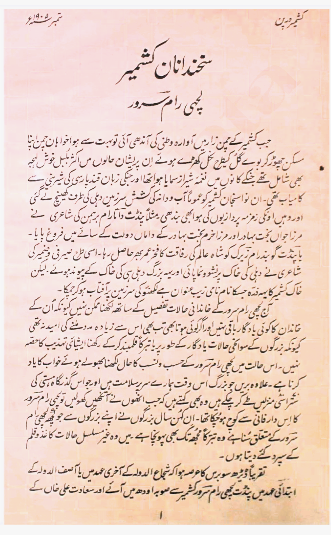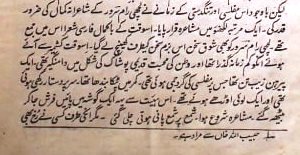(Kashmir Rechords Exclusive)
In the early 1900s, the “Kashmir Darpan” magazine captured the spirit of young Kashmiri poets driven by wanderlust and a deep love for Persian poetry. Among these seekers of new horizons was Pandit Lachhi Ram Saroor, whose life story unfolds through the rich oral traditions and historical accounts preserved in the magazine’s 1905 edition.
Early Life and Migration
Approximately 150 years before the publication of “Kashmir Darpan,” around 1755 A.D., Lachhi Ram Saroor left his native Kashmir for the culturally vibrant region of Awadh. This era marked the twilight of Nawab Shuja-ud-Daula’s rule and the dawn of Asaf-ud-Daula’s governance. Saroor’s migration was a journey into a world where Persian poetry thrived under the patronage of local rulers and the literary community flourished.

Engagement with Kandhari Publications
Upon arriving in Awadh, Saroor became deeply involved with the Kandhari publications, a significant literary outlet of the time. The Kandharis, speculated to be earlier Kashmiri migrants, provided a platform for Saroor and others to express their poetic talents. Pandit Zinda Ram, another Kashmiri, served as a scribe and later ascended to the role of Chief Manager within these publications. His collaboration with Saroor highlighted the prominent role that Kashmiris played in shaping Awadh’s literary landscape.
Romantic Bonds and Poetic Muse: Habibullah Khan

A noteworthy aspect of Lachhi Ram Saroor’s life was his relationship with another Kashmiri, Habibullah Khan, who also held a managerial position at the Kandhari publications. Their bond transcended professional collaboration, blossoming into a romantic relationship that profoundly influenced Saroor’s poetry. His verses often celebrated the beauty and charm of Habibullah Khan, reflecting the deep affection and admiration he felt. One of Saroor’s evocative couplets captures this sentiment:
“The beloved made the houri assume a human form, Behold the joy that mirrors the shadow of the majestic god. The promise of joy composed in honor of Youssuf Applies to the face of the beloved, for you may have misunderstood His beauty is purity in another dimension.”
Turmoil and Migration to Indore
Saroor’s time in Awadh was not without challenges. When court intrigues turned the Nawab of Awadh against Pandit Zinda Ram, both Zinda Ram and Saroor were forced to leave. Demonstrating his loyalty and solidarity, Saroor accompanied Zinda Ram to Indore. There, they sought patronage under Maharaja Holker. Despite the initial respect they received, their integration into Holker’s court was thwarted by the surrounding intrigues and politics. Disillusioned, Zinda Ram returned to Awadh, prompting Saroor to satirize Maharaja Holker’s one eye blindness in his poignant verses:
“Friends, Cast away the desire for silver and gold, Take the road home and abandon the journey. Expecting sight from this blind eye is a mistake, Seek vision from the one who sees, not from one who is blind.”

Literary Contributions and Legacy
Lachhi Ram Saroor’s literary legacy is preserved through his “Diwan” (collection of poems), which is a testament to his prowess in the Persian ghazal form. His handwritten manuscripts have been treasured by the elders, with “Kashmir Darpan” confirming the authenticity and quality of his work. Saroor’s poetry, influenced by the style of the renowned Persian poet Shirazi, encompasses themes of love, beauty, and longing. His collection includes nearly a hundred ghazals, meticulously crafted with attention to “Radeef” (a refrain in Persian poetry), alongside a “Masnavi” and a “Qaseeda” in honor of Habibullah Khan. True to the poetic tradition, his verses evoke themes of love, beauty, and longing for the beloved.
Enduring Kashmiri Traditions
Despite his journeys and the challenges he faced, Lachhi Ram Saroor remained deeply rooted in his Kashmiri heritage. He never amassed wealth from his Masnavis. He steadfastly wore the traditional “Pheran,” symbolizing his connection to his homeland. Even as he navigated the diverse cultural landscapes of Awadh and Indore, his distinctive turban, though often soiled, graced his head with dignity and pride.

A Poet’s Resilience and Cultural Impact
Lachhi Ram Saroor’s life story, as detailed in the “Kashmir Darpan,” highlights not only his personal journey but also the broader narrative of Kashmir’s influence on Indian literary culture. His enduring commitment to his poetic craft, his romantic inclinations, and his unwavering adherence to Kashmiri traditions reflect the resilient spirit of the Kashmiri diaspora and their significant contributions to the cultural fabric of India.

